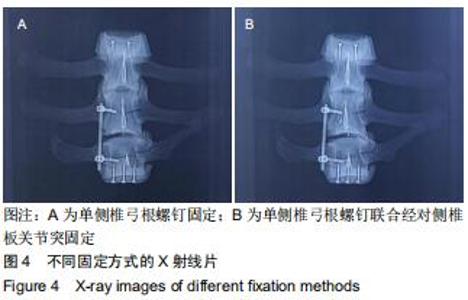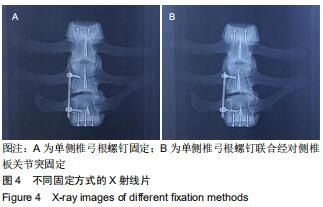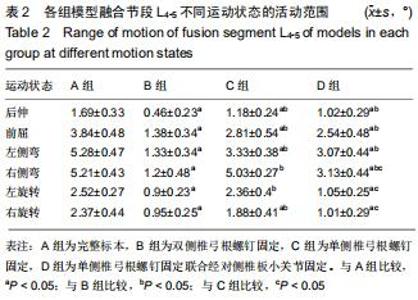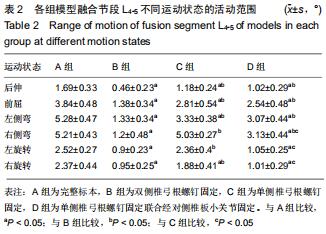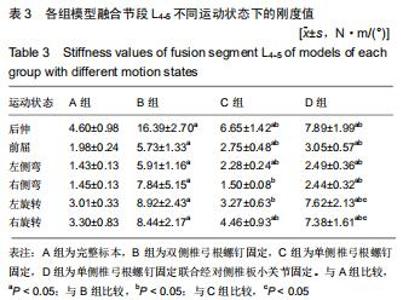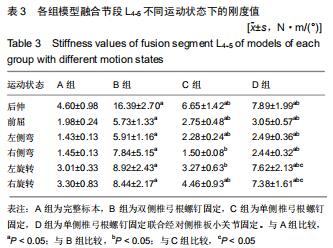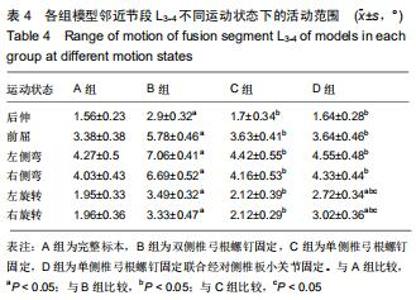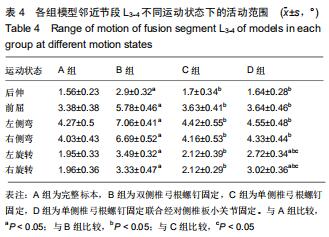Chinese Journal of Tissue Engineering Research ›› 2020, Vol. 24 ›› Issue (27): 4297-4304.doi: 10.3969/j.issn.2095-4344.2793
Previous Articles Next Articles
Biomechanical characteristics of transforaminal lumbar interbody fusion combined with different pedicle screw fixation methods in single-segment lumbar spine and adjacent segments
Hou Jichun, Cao Yang
- Department of Orthopedics, First Affiliated Hospital of Harbin Medical University, Harbin 150001, Heilongjiang Province, China
-
Received:2019-12-19Revised:2019-12-28Accepted:2020-02-19Online:2020-09-28Published:2020-09-07 -
Contact:Cao Yang, Chief physician, Department of Orthopedics, First Affiliated Hospital of Harbin Medical University, Harbin 150001, Heilongjiang Province, China -
About author:Hou Jichun, Master candidate, Physician, Department of Orthopedics, First Affiliated Hospital of Harbin Medical University, Harbin 150001, Heilongjiang Province, China -
Supported by:a grant from the Science and Technology Bureau of Harbin City, No. 2013AA3BS016
CLC Number:
Cite this article
Hou Jichun, Cao Yang. Biomechanical characteristics of transforaminal lumbar interbody fusion combined with different pedicle screw fixation methods in single-segment lumbar spine and adjacent segments[J]. Chinese Journal of Tissue Engineering Research, 2020, 24(27): 4297-4304.
share this article
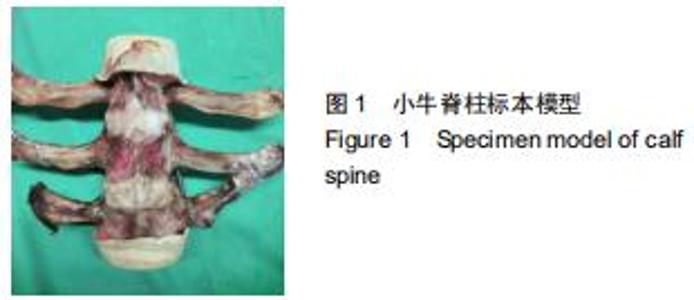
1.3 材料 选取18只市售9月龄新鲜小牛L3-5脊柱标本,所有标本在宰杀后第一时间剔除适量肌肉及脂肪组织,并保持韧带、椎间盘及关节突的完整性,在X射线下排除创伤性、肿瘤性或代谢性等其他疾病,确认标本完整后,在标本两端各钻入30 mm螺钉增加稳定性,并用牙托粉(义齿基托树脂II型)将两端包埋固定,在维持腰椎正常生理曲度的同时确定两端包埋平行(图1)。包埋完成后,用保鲜膜包裹存放于-20 ℃的环境中[18]。在实验测试前,将标本在室温24 ℃的环境下自然解冻至可以完全屈伸。测量采用MTS脊柱运动测试机(图2)、三维动态捕捉仪器,由天津骨科研究所提供。椎弓根钉棒由北京威高亚华人工关节开发有限公司提供,椎间融合器由北京理贝尔生物工程研究生有限公司提供,见图3,表1。 "
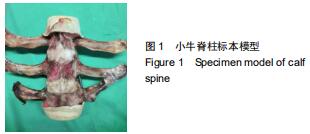
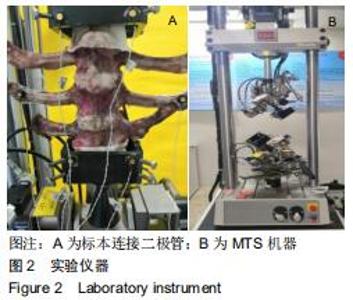
1.3 材料 选取18只市售9月龄新鲜小牛L3-5脊柱标本,所有标本在宰杀后第一时间剔除适量肌肉及脂肪组织,并保持韧带、椎间盘及关节突的完整性,在X射线下排除创伤性、肿瘤性或代谢性等其他疾病,确认标本完整后,在标本两端各钻入30 mm螺钉增加稳定性,并用牙托粉(义齿基托树脂II型)将两端包埋固定,在维持腰椎正常生理曲度的同时确定两端包埋平行(图1)。包埋完成后,用保鲜膜包裹存放于-20 ℃的环境中[18]。在实验测试前,将标本在室温24 ℃的环境下自然解冻至可以完全屈伸。测量采用MTS脊柱运动测试机(图2)、三维动态捕捉仪器,由天津骨科研究所提供。椎弓根钉棒由北京威高亚华人工关节开发有限公司提供,椎间融合器由北京理贝尔生物工程研究生有限公司提供,见图3,表1。"
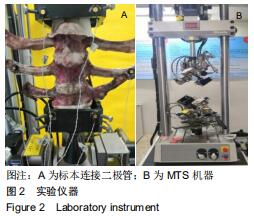
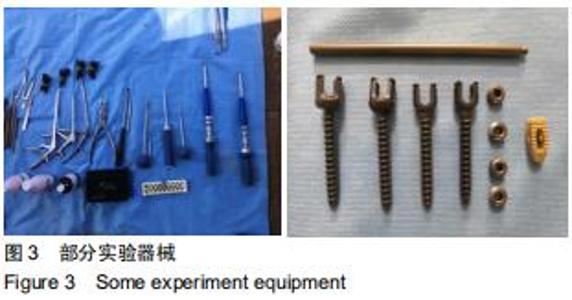
1.3 材料 选取18只市售9月龄新鲜小牛L3-5脊柱标本,所有标本在宰杀后第一时间剔除适量肌肉及脂肪组织,并保持韧带、椎间盘及关节突的完整性,在X射线下排除创伤性、肿瘤性或代谢性等其他疾病,确认标本完整后,在标本两端各钻入30 mm螺钉增加稳定性,并用牙托粉(义齿基托树脂II型)将两端包埋固定,在维持腰椎正常生理曲度的同时确定两端包埋平行(图1)。包埋完成后,用保鲜膜包裹存放于-20 ℃的环境中[18]。在实验测试前,将标本在室温24 ℃的环境下自然解冻至可以完全屈伸。测量采用MTS脊柱运动测试机(图2)、三维动态捕捉仪器,由天津骨科研究所提供。椎弓根钉棒由北京威高亚华人工关节开发有限公司提供,椎间融合器由北京理贝尔生物工程研究生有限公司提供,见图3,表1。"
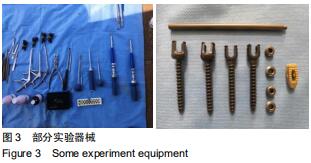
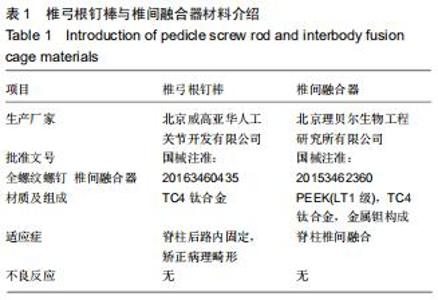
1.3 材料 选取18只市售9月龄新鲜小牛L3-5脊柱标本,所有标本在宰杀后第一时间剔除适量肌肉及脂肪组织,并保持韧带、椎间盘及关节突的完整性,在X射线下排除创伤性、肿瘤性或代谢性等其他疾病,确认标本完整后,在标本两端各钻入30 mm螺钉增加稳定性,并用牙托粉(义齿基托树脂II型)将两端包埋固定,在维持腰椎正常生理曲度的同时确定两端包埋平行(图1)。包埋完成后,用保鲜膜包裹存放于-20 ℃的环境中[18]。在实验测试前,将标本在室温24 ℃的环境下自然解冻至可以完全屈伸。测量采用MTS脊柱运动测试机(图2)、三维动态捕捉仪器,由天津骨科研究所提供。椎弓根钉棒由北京威高亚华人工关节开发有限公司提供,椎间融合器由北京理贝尔生物工程研究生有限公司提供,见图3,表1。"
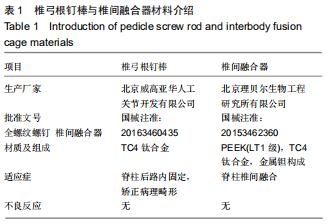
|
[1] LIU HY, ZHOU J, WANG B, et al. Comparison of Topping-off and posterior lumbar interbody fusion surgery in lumbar degenerative disease: a retrospective study.Chin Med J (Engl). 2012;125(22): 3942-3946.
[2] ELIYAS JK, KARAHALIOS D. Surgery for degenerative lumbar spine disease.Dis Mon. 2011;57(10):592-606.
[3] TCHAKO A, SADEGH AM. Stress changes in intervertebral discs of the cervical spine due to partial discectomies and fusion.J Biomech Eng.2009;131(5):51013.
[4] CHO CB, RYU KS, PARK CK. Anterior lumbar interbody fusion with stand-alone interbody cage in treatment of lumbar intervertebral foraminal stenosis : comparative study of two different types of cages.J Korean Neurosurg Soc.2010;47(5):352-357.
[5] 董健文,邱奕雁,赵卫东,等.单侧椎弓根钉棒固定单节段腰椎及其邻近节段生物力学研究[J].中国临床解剖学杂志,2010,28(1):85-89.
[6] HU Y, ZHU BK, KEPLER CK, et al.A Comparison Study of Three Posterior Fixation Strategies in Transforaminal Lumbar Interbody Fusion Lumbar for the Treatment of Degenerative Diseases. Indian J Orthop.2019;53(4):542-547.
[7] CHEN DJ, YAO C, SONG Q, et al. Unilateral versus Bilateral Pedicle Screw Fixation Combined with Transforaminal Lumbar Interbody Fusion for the Treatment of Low Lumbar Degenerative Disc Diseases: Analysis of Clinical and Radiographic Results. World Neurosurg.2018;115:e516-e522.
[8] LU P, PAN T, DAI T, et al. Is unilateral pedicle screw fixation superior than bilateral pedicle screw fixation for lumbar degenerative diseases: a meta-analysis.J Orthop Surg Res.2018;13(1):296.
[9] ZENG ZY, WU P, SONG YX, et al. Unilateral pedicle screw fixation combined with contralateral percutaneous translaminar facet screw fixation and lumbar interbody fusion for the treatment of lower lumbar diseases: an analysis of complications.Zhongguo Gu Shang.2016;29(3):232-241.
[10] KABINS MB, WEINSTEIN JN, SPRATT KF, et al. Isolated L4-L5 fusions using the variable screw placement system: unilateral versus bilateral.J Spinal Disord.1992;5(1):39-49.
[11] SUK KS, LEE HM, KIM NH, et al. Unilateral versus bilateral pedicle screw fixation in lumbar spinal fusion.Spine(Phila Pa 1976). 2000;25(14):1843-1847.
[12] FERNANDEZ-FAIREN M, SALA P, RAMIREZ H, et al. A prospective randomized study of unilateral versus bilateral instrumented posterolateral lumbar fusion in degenerative spondylolisthesis. Spine(Phila Pa 1976).2007;32(4):395-401.
[13] BERINGER WF, MOBASSER JP. Unilateral pedicle screw instrumentation for minimally invasive transforaminal lumbar interbody fusion.Neurosurg Focus.2006;20(3):E4.
[14] TUTTLE J, SHAKIR A, CHOUDHRI HF. Paramedian approach for transforaminal lumbar interbody fusion with unilateral pedicle screw fixation. Technical note and preliminary report on 47 cases. Neurosurg Focus.2006;20(3):E5.
[15] SLUCKY AV, BRODKE DS, BACHUS KN, et al. Less invasive posterior fixation method following transforaminal lumbar interbody fusion: a biomechanical analysis.Spine J.2006;6(1): 78-85.
[16] KASAI Y, INABA T, KATO T, et al. Biomechanical study of the lumbar spine using a unilateral pedicle screw fixation system.J Clin Neurosci.2010;17(3):364-367.
[17] BEST NM, SASSO RC. Efficacy of translaminar facet screw fixation in circumferential interbody fusions as compared to pedicle screw fixation.J Spinal Disord Tech.2006;19(2):98-103.
[18] WILKE HJ, WENGER K, CLAES L. Testing criteria for spinal implants: recommendations for the standardization of in vitro stability testing of spinal implants.Eur Spine J.1998;7(2):148-154.
[19] GODZIK J, MARTINEZ-DEL-CAMPO E, NEWCOMB A, et al. Biomechanical Stability Afforded by Unilateral Versus Bilateral Pedicle Screw Fixation with and without Interbody Support Using Lateral Lumbar Interbody Fusion.World Neurosurg. 2018;113: e439-e445.
[20] PHILLIPS FM, TZERMIADIANOS MN, VORONOV LI, et al. Effect of the Total Facet Arthroplasty System after complete laminectomy-facetectomy on the biomechanics of implanted and adjacent segments. Spine J.2009;9(1):96-102.
[21] GONG Z, CHEN Z, FENG Z, et al. Finite element analysis of 3 posterior fixation techniques in the lumbar spine.Orthopedics. 2014;37(5):e441-e448.
[22] LUO B, YAN M, HUANG J, et al. Biomechanical study of unilateral pedicle screw combined with contralateral translaminar facet screw in transforaminal lumbar interbody fusion. Clin Biomech (Bristol, Avon).2015;30(7):657-661.
[23] 张昊,胡亚威,菅新民,等.两种不同椎弓根螺钉内固定术式对腰椎稳定性影响的生物力学对比研究[J].中国临床解剖学杂志, 2016,34(2): 220-223.
[24] YANG M, SUN G, GUO S, et al. The Biomechanical Study of Extraforaminal Lumbar Interbody Fusion: A Three-Dimensional Finite-Element Analysis.J Healthc Eng.2017;2017:9365068.
[25] 何蔚,张桦,何海龙,等.腰椎单侧及双侧椎弓根螺钉固定椎间融合器的生物力学研究[J].解放军医学杂志,2009,34(4):405-408.
[26] ZHAO C, WANG X, CHEN C, et al. Finite element analysis of minimal invasive transforaminal lumbar interbody fusion.Cell Biochem Biophys.2014;70(1):609-613.
[27] 陈志明,马华松,赵杰,等.腰椎单侧椎弓根螺钉固定的三维有限元分析[J].中国脊柱脊髓杂志, 2010,20(8):684-688.
[28] 邵高海,焦春燕,余雨,等.单侧椎弓根螺钉置入并椎间融合对邻近椎间盘节段退变的影响[J].中国组织工程研究与临床康复, 2011, 15(13):2317-2321.
[29] 何蔚,张桦,何海龙,等.腰椎单侧及双侧椎弓根螺钉固定椎间融合器的生物力学研究[J].解放军医学杂志,2009,34(4):405-408.
[30] OKUDA S, IWASAKI M, MIYAUCHI A, et al. Risk factors for adjacent segment degeneration after PLIF.Spine(Phila Pa 1976). 2004;29(14):1535-1540.
[31] SHONO Y, KANEDA K, ABUMI K, et al. Stability of posterior spinal instrumentation and its effects on adjacent motion segments in the lumbosacral spine.Spine (Phila Pa 1976). 1998;23(14): 1550-1558.
[32] 曾忠友,吴鹏,宋永兴,等.小切口单侧椎弓根螺钉联合对侧经皮椎板关节突螺钉固定并椎间融合治疗腰椎病变的并发症分析[J].中国骨伤,2016,29(3):232-241.
[33] 曾忠友,吴鹏,孙德弢,等.两种不同固定方式并椎间融合治疗腰椎双节段病变的临床对比研究[J].中国骨伤,2015,28(10):903-909. [34]曾忠友,吴鹏,毛克亚,等.单侧椎弓根螺钉固定与联合对侧椎板关节突螺钉固定应用于下腰椎单节段病变的临床研究[J].中国骨伤, 2015,28(4):306-312. |
| [1] | Xu Feng, Kang Hui, Wei Tanjun, Xi Jintao. Biomechanical analysis of different fixation methods of pedicle screws for thoracolumbar fracture [J]. Chinese Journal of Tissue Engineering Research, 2021, 25(9): 1313-1317. |
| [2] | Yao Rubin, Wang Shiyong, Yang Kaishun. Minimally invasive transforaminal lumbar interbody fusion for treatment of single-segment lumbar spinal stenosis improves lumbar-pelvic balance [J]. Chinese Journal of Tissue Engineering Research, 2021, 25(9): 1387-1392. |
| [3] | Chen Xinmin, Li Wenbiao, Xiong Kaikai, Xiong Xiaoyan, Zheng Liqin, Li Musheng, Zheng Yongze, Lin Ziling. Type A3.3 femoral intertrochanteric fracture with augmented proximal femoral nail anti-rotation in the elderly: finite element analysis of the optimal amount of bone cement [J]. Chinese Journal of Tissue Engineering Research, 2021, 25(9): 1404-1409. |
| [4] | Zhou Jihui, Li Xinzhi, Zhou You, Huang Wei, Chen Wenyao. Multiple problems in the selection of implants for patellar fracture [J]. Chinese Journal of Tissue Engineering Research, 2021, 25(9): 1440-1445. |
| [5] | Hou Guangyuan, Zhang Jixue, Zhang Zhijun, Meng Xianghui, Duan Wen, Gao Weilu. Bone cement pedicle screw fixation and fusion in the treatment of degenerative spinal disease with osteoporosis: one-year follow-up [J]. Chinese Journal of Tissue Engineering Research, 2021, 25(6): 878-883. |
| [6] | Song Chengjie, Chang Hengrui, Shi Mingxin, Meng Xianzhong. Research progress in biomechanical stability of lateral lumbar interbody fusion [J]. Chinese Journal of Tissue Engineering Research, 2021, 25(6): 923-928. |
| [7] | Xu Yulin, Shen Shi, Zhuo Naiqiang, Yang Huilin, Yang Chao, Li Yang, Zhao Heng, Zhao Lu. Biomechanical comparison of three different plate fixation methods for acetabular posterior column fractures in standing and sitting positions [J]. Chinese Journal of Tissue Engineering Research, 2021, 25(6): 826-830. |
| [8] | Cai Qunbin, Zou Xia, Hu Jiantao, Chen Xinmin, Zheng Liqin, Huang Peizhen, Lin Ziling, Jiang Ziwei. Relationship between tip-apex distance and stability of intertrochanteric femoral fractures with proximal femoral anti-rotation nail: a finite element analysis [J]. Chinese Journal of Tissue Engineering Research, 2021, 25(6): 831-836. |
| [9] | Xie Chongxin, Zhang Lei. Comparison of knee degeneration after anterior cruciate ligament reconstruction with or without remnant preservation [J]. Chinese Journal of Tissue Engineering Research, 2021, 25(5): 735-740. |
| [10] | Zhou Jihui, Li Xinzhi, Zhou You, Huang Wei, Chen Wenyao. Comparison of the advantages and disadvantages of multiple implants in treatment of traumatic dislocation of sternoclavicular joint [J]. Chinese Journal of Tissue Engineering Research, 2021, 25(3): 443-448. |
| [11] | Nie Shaobo, Li Jiantao, Sun Jien, Zhao Zhe, Zhao Yanpeng, Zhang Licheng, Tang Peifu. Mechanical stability of medial support nail in treatment of severe osteoporotic intertrochanteric fracture [J]. Chinese Journal of Tissue Engineering Research, 2021, 25(3): 329-333. |
| [12] | Tan Jiachang, Yuan Zhenchao, Wu Zhenjie, Liu Bin, Zhao Jinmin. Biomechanical analysis of elastic nail combined with end caps and wire fixation for long oblique femoral shaft fractures [J]. Chinese Journal of Tissue Engineering Research, 2021, 25(3): 334-338. |
| [13] | Chen Lu, Zhang Jianguang, Deng Changgong, Yan Caiping, Zhang Wei, Zhang Yuan. Finite element analysis of locking screw assisted acetabular cup fixation [J]. Chinese Journal of Tissue Engineering Research, 2021, 25(3): 356-361. |
| [14] | Li Kun, Li Zhijun, Zhang Shaojie, Gao Shang, Sun Hao, Yang Xi, Wang Xing, Dai Lina . A 4-year-old child model of occipito-atlanto-axial joints established by finite element dynamic simulation [J]. Chinese Journal of Tissue Engineering Research, 2021, 25(24): 3773-3778. |
| [15] | Qian Xuankun, Huang Hefei, Wu Chengcong, Liu Keting, Ou Hua, Zhang Jinpeng, Ren Jing, Wan Jianshan. Computer-assisted navigation combined with minimally invasive transforaminal lumbar interbody fusion for lumbar spondylolisthesis [J]. Chinese Journal of Tissue Engineering Research, 2021, 25(24): 3790-3795. |
| Viewed | ||||||
|
Full text |
|
|||||
|
Abstract |
|
|||||
